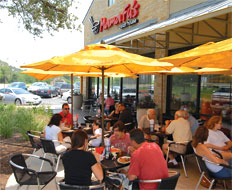Menu innovation remains one of the best ways a brand can stay fresh in consumers’ minds, and quick serves are taking product development to another level by partnering with other food brands to create new menu items.
These partnerships have created some of the most successful product launches in recent memory, including Taco Bell’s Doritos Locos Tacos and Popeyes’ Zatarain’s Butterfly Shrimp, to name a few.
Cobranding—whether with a familiar consumer packaged goods brand or another limited-service player—creates a unique opportunity for operators to provide new products leveraging brands that consumers are already familiar with, says Kat Cole, president of Cinnabon. But creating a successful cobranded product isn’t as easy as it sounds. Behind every cobranded product’s success are a lot of steps that helped take the product from idea to reality and helped make it a hit with consumers.
There are a few primary ways restaurant operators can work with another brand to create a cobranded product, Cole says: feature a co-created product on the menu; work with a brand to use a licensed ingredient on the menu, like how Burger King sells Cinnabon’s Minibons product; or open cobranded units with a complementary concept.
Picking the right brand to work with is often the first and most critical step to cobranding. Dan Beem, president of Cold Stone Creamery, says the partnership must positively affect both brands or else it won’t translate effectively to the consumer.
“Each time we approach an opportunity to cobrand, we try to think of it this way: Would these two brands be friends in real life? If they would, then the customer won’t be confused,” he says.
For Cold Stone, a partnership with Tim Hortons, the popular Canadian coffee chain, made sense for the company and enticed fans of both brands. The two companies teamed up in 2009 to open cobranded cafés that featured a menu consisting of both brands’ products.
The best collaborations are able to cover both brands’ interests by delivering the quality that fans expect while creating new consumers for each brand. Karen Post, branding expert and writer for RestaurantBrandingRoadmap.com, says the main objective for brands considering cobranding is to make sure that both companies’ personas are compatible and create what she calls “thoughtful harmony.”
In the case of the Doritos and Taco Bell collaboration, she says, the two companies did a great job recognizing similar brand priorities. “They’re a natural fit. They both have a young, active, fun market and they market in the same space,” Post says. “They both also are big into advertising, so the outcome into the marketplace can be really big.”
Cole says operators who are considering working with another brand on a cobranded product should be ready to do a lot of research. Both brands must be willing to invest in understanding the potential new products and how their consumers will feel about them. If consumers react negatively to a cobranded offering, it can be damaging to both brands’ image, she says.
Before Burger King launched Minibons nationwide, Cinnabon spent more than a year testing the product, its packaging, operating procedures, and how consumers felt about the product’s taste and its perceived value. “It’s not something we just jumped into,” Cole says. Investing in understanding the product and consumer interest in the product “gives us the confidence and competency to work with a large company like Burger King,” she says.
Post says quick-serve companies that are considering working with other brands to create cobranded products should also look intensely at the cost of creating, marketing, and implementing a new product.
“Even if it’s just a display of another company’s product in the store or restaurant, you have to look at the cost to do it versus the outcome,” she says. “An operator needs to be sensitive to cost effectiveness.”
Post recommends running trials at a limited number of stores for a short period of time to test the market and examine the sales. This is exactly what Cinnabon did when making sure that its Minibons would work well in Burger King stores. Before rolling out the item nationwide, Burger King ran a test in key cities to see if consumers reacted well to the new product and if the stores could execute them in a way that pleased both brands.
“The question was, Can [Burger King] execute the standard that Cinnabon customers are used to?” Cole says. “It turned out that the Minibons were a platform that worked well.”
Post says both brands must be very clear about what their goals are in a cobranding relationship before they even start to brainstorm ideas for products or combined concepts.
“You need to make sure there is common ground with both brands’ goals,” she says. “Then you need to make sure everything is outlined in a written contract.”
Not only can cobranding opportunities expand the consumer base of each concept, but they can also be a chance to create sales opportunities in dayparts or menu segments that didn’t exist before.
At Cold Stone, Beem looks specifically at seasonality. Its collaboration with Tim Hortons means that in colder months, when ice cream sales are down, consumers can come into the store for a warm beverage.
“Cobranding can be an opportunity to drive incremental revenue for different parts of sales,” he says. “If you sell $1 more on a cobranded product, you will see it benefit the bottom line.”









